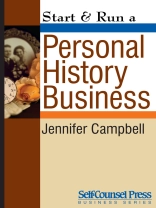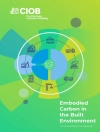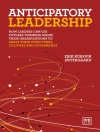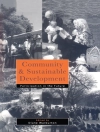Anyone interested in genealogy, personal history and memoirs can turn their passion into a business. Communities, families, and even corporations are increasingly seeking out professional writers and historians to record their stories. For anyone who is interested in personal history and writing, this is an essential resource for turning your passion into an income source. Written by experienced personal historian and entrepreneur Jennifer Campbell, it covers topics such as: how to actually do the work, starting up, education and training, marketing and expansion. All books in the Self-Counsel Press Start & Run series are written in clear language and includes a download kit packed with resources and templates to help you get started. This download kit includes: a template for a first project, a sample business plan, a sample marketing plan, links to associations and online resources, examples of personal history research – and more!
Table of Content
1 THE WORLD OF PERSONAL HISTORY 1
1. What Is a Personal Historian? An Introduction 1
2. The World of Personal History 2
2.1 A business that’s timely — and timeless 2
2.2 The memoirs and genealogy phenomenon: Capturing the moment —
Past, present, and future 3
2.3 Honoring the past in a rapidly changing world 3
2.4 The need for story 4
2.5 Mind, body, and spirit 5
3. Genealogy and Personal History 7
3.1 How a personal historian can work with a genealogist 7
4. Ten Essential Things You’ll Learn from This Book 8
5. Summary 9
2 THE BUSINESS OF PERSONAL HISTORY 10
1. What You Need to Know about Being a Personal Historian 10
1.1 Suitable backgrounds and interests 10
1.2 Age 11
vi Start & run a personal history business
1.3 Solo or partners 11
1.4 A family affair 11
1.5 Five really great things about a personal history business 11
2. Is This Right for You? 12
2.1 Work preferences 12
2.2 Financial circumstances 12
2.3 Times of trial and tribulation 15
2.4 Lifestyle considerations 15
3. Terms You Should Know 16
3 GETTING STARTED 18
1. The Entrepreneurial Attitude: Are You a Pair of Hands or a Visionary? 18
2. Start Here; Get There 19
2.1 Total immersion: Absorb as much as you can about the fi eld 19
3. Business Research and Preparation 21
3.1 Know thy market 21
3.2 Brush up on or learn computer skills 22
3.3 Create a mini mission statement (by writing down your goals) 22
3.4 Check out potential competition 22
3.5 Set up your offi ce 22
3.6 Start spreadin’ the news 22
4 BUSINESS FOUNDATIONS 23
1. Branding: Finding the Essence of Your Company 23
1.1 What is a brand? 23
1.2 Business name 23
1.3 Tagline 25
1.4 Logo 25
2. Your Business Plan 26
2.1 Why a business plan is essential 26
2.2 Parts of your business plan 26
3. Legalities 34
3.1 Registering your business name 34
3.2 Business bank account 34
3.3 Taxation issues 34
Contents vii
3.4 Get it in writing: Your legal documents 37
4. Help from Experts 46
4.1 Lawyer 46
4.2 Accountant 46
4.3 Insurance agent 46
4.4 Support groups 47
5. What You Need 48
5.1 Equipment 48
5.2 Software 51
5.3 Workspace 52
5.4 Reference books and subscriptions 52
5 PRICING 54
1. Pricing Strategy 54
1.1 Good, better, best 54
1.2 Your position in the marketplace 55
1.3 Other factors determining your pricing strategy 55
2. Methodology: Hourly Charge or Package Price? 56
2.1 Hourly charge pros and cons 56
2.2 Package price pros and cons 57
3. Pricing Your Services for Profi t 58
3.1 Determining project scope: How much does a typical personal history cost? 58
3.2 Phase 1: The manuscript 58
3.3 Phase 2: Book publication 61
6 PRODUCE A SAMPLE 64
1. Produce a Sample for Your Customers 64
2. Produce a Sample for Yourself 65
3. Produce a Sample for Your Pricing Plans 65
3.1 Time yourself 65
3.2 Accounting for expenses 66
4. Free or Not? 66
5. Help! I Don’t Have a Sample But I Do Have a Lead! 67
6. Steps to Create a Personal History (Sample or Paid Project) 67
viii Start & run a personal history business
7 FROM “TESTING, TESTING” TO PRINT:
A STEP-BY-STEP GUIDE TO PRODUCING A
PERSONAL HISTORY 69
1. Prepare a Project Plan 69
2. The Pre-Interview 70
3. Scheduling the Interviews 70
3.1 How many interviews do you need? 70
3.2 How long should you allow for each interview? 70
3.3 What’s the best time? 71
4. Transcribing 71
4.1 Hiring a transcriber 71
4.2 Style guide 72
4.3 Reviewing the transcript 73
5. Transcript to Manuscript 73
5.1 The unique nature of a personal history manuscript 73
5.2 First person or third person? 73
5.3 The editing process 74
5.4 Polish 81
5.5 Client review of fi rst draft 81
5.6 Editing a manuscript that’s already written 83
6. Book Production 83
6.1 First step: The vision 84
6.2 Custom design 84
6.3 Do it yourself 84
6.4 Book decisions 85
6.5 Photos 85
6.6 Printing and binding options 88
7. Producing a CD 89
7.1 The audio recording as the end product 89
8 THE INTERVIEW — THE HEART OF PERSONAL HISTORY 91
1. What Makes a Good Interview? 91
1.1 You can lead a horse to water … 91
1.2 A safe and open environment 92
Contents ix
2. Pre-Interview Preparation 93
2.1 How many, how long, how often 94
2.2 Time and place 94
2.3 Information gathering 94
3. Structuring the Interviews 95
3.1 Audio-only (interviews on CD) 95
3.2 Transcript or lightly-edited transcript 95
3.3 Fully edited manuscript or book 95
4. Your First Interview with a New Client 100
4.1 Preparing your client 101
4.2 Preparing yourself 101
5. The Interview Environment 102
6. Establishing Rapport 102
7. Listening 103
8. Interviewing Techniques 103
8.1 He said, she said: Achieving balance 103
8.2 Assess your narrator and tailor your questions 103
8.3 Fear not the silence 105
8.4 Keep it fl owing 105
8.5 Go beyond the surface 105
8.6 Assume nothing 107
8.7 Keeping the focus on your narrator 107
8.8 Keeping on track 107
8.9 Interviewing more than one person 107
8.10 Ending an interview 108
8.11 Special considerations when dealing with the elderly 108
9 MARKETING 111
1. Market Research 111
1.1 Why you need market research 111
1.2 Customers 112
1.3 Understanding your competition 112
1.4 SWOT (Strengths, Weaknesses, Opportunities, Threats) 112
1.5 Suppliers 113
x Start & run a personal history business
1.6 Market trends 113
1.7 Primary and secondary resources 113
1.8 Primary research: A customer survey 113
1.9 Sources of secondary research 114
2. Marketing Your Business 114
2.1 Your message 115
2.2 Your marketing plan 115
2.3 Marketing to the 50+ demographic 116
2.4 Marketing materials 119
10 YOUR ONLINE PRESENCE 122
1. Your Website 122
1.1 Do you really need a website? 122
1.2 Do it now 122
1.3 Do it yourself or hire a pro? 123
1.4 Domain name 123
1.5 Web hosting 123
1.6 Navigation/general 124
1.7 Value-added content 124
1.8 Sections of your website 124
1.9 Look and feel 127
2. Writing for a Personal History Website 127
3. Search Engine Optimization (SEO) 128
4. Other Tips 129
4.1 Your email signature 129
4.2 Website or blog? 129
4.3 Social Media: Linked In/Facebook/Twitter/Eons/My Space/You Tube 129
4.4 E-newsletter/e-zine 130
11 PUBLICITY, PROMOTION, AND REACHING YOUR CLIENTS 132
1. The Best Things in Publicity Are Free: Getting Covered in Newspapers,
Magazines, and on Radio and TV 132
1.1 Know your angle 132
1.2 Writing a press release 133
1.3 Be prepared 134
Contents xi
1.4 Television and radio 134
2. Public Speaking: Discover Your Inner Ham 135
2.1 Wrestle your demons 135
2.2 Why it’s important 135
2.3 Opportunity knocks: Suggestions for what to speak about and where to speak 135
3. Trade Shows 137
4. Local Fairs, Festivals, and Conferences 138
5. Connecting with People 138
5.1 Face-to-face 138
5.2 Be everywhere and be your business 138
5.3 Local connectors 139
5.4 Referrals from former clients 139
5.5 Complementary/supplementary business colleagues 139
5.6 Networking and working the ’Net 140
5.7 Networking groups 140
5.8 Relevant associations 140
5.9 Make alliances 141
5.10 Join for fun! 141
5.11 Volunteer 141
6. Contact Management 142
7. Advertising 142
7.1 Quantity and quality 142
7.2 Making it count 142
12 SALES 144
1. Before the Meeting: Preparation 144
1.1 Your sales folder 144
1.2 Your samples 145
1.3 Prepare yourself 145
2. During the Meeting: Show Time! 146
2.1 Build rapport and establish parameters 146
2.2 Establish emotional connection 146
2.3 Talk price 146
2.4 Are you talking to the decision-maker? 147
xii Start & run a personal history business
2.5 Your sales presentation 147
2.6 Closing the sale 148
2.7 Winning a “yes” from a “no” customer 148
2.8 Contract at the ready 149
2.9 “No” just means “not right now” 149
2.10 After the meeting 149
3. Sales Possibilities 149
3.1 Turning a $600 project into a $6, 000 project 150
3.2 Cross-selling 150
4. Repeat Business: Marketers Would Kill for the Information You Have 150
5. Cold Calling 151
13 CLIENT RELATIONS AND CUSTOMER SERVICE: NURTURING
AND MANAGING POTENTIAL AND CURRENT CLIENTS 153
1. Communication 153
1.1 Active listening 153
1.2 Methods of communicating 154
1.3 Absences 154
1.4 Frequency of communication 154
1.5 Honesty and openness 154
1.6 Confl icts 155
1.7 Expectations 155
2. The Many Hats of Customer Service 155
3. How Can I Wow? 156
3.1 Let’s give them something to talk about 156
14 TIME MANAGEMENT AND PROJECT MANAGEMENT 158
1. Time Management 158
1.1 Stay focused on the real priorities 158
1.2 Recognize your work habits 159
1.3 Take a break 159
1.4 Email and the Internet: The great time wasters 159
2. Project Management 160
2.1 Schedule your projects 160
2.2 Plan your projects 160
Contents xiii
2.3 Track your time 160
2.4 In sickness and in health 161
2.5 Work fl ow 161
2.6 Managing diffi cult clients 163
15 GROWING YOUR BUSINESS 164
1. Expand Your Offerings 164
1.1 Questions of the heart and soul: Ethical wills and legacy letters 164
1.2 If these walls could talk! House or heritage building histories 168
1.3 Corporate or business histories 168
1.4 Family reunions 169
1.5 Community/local histories 169
1.6 Engagement and wedding books 170
1.7 Memorial books or books of remembrance 170
1.8 Pet tributes 170
1.9 Videobiographies 170
2. Teaching Life-Writing Workshops 170
2.1 Length and venue 170
2.2 Pricing 171
2.3 Preparation 172
2.4 Environment 172
2.5 Structure 172
3. Coaching 172
3.1 Coaching memoir writers 172
3.2 Coaching personal historians 173
16 ACCELERATING YOUR SUCCESS AND MANAGING
BUSINESS GROWTH 174
1. Avoid Burnout 174
2. Avoid Veering off Course 174
3. Defi nitely Don’t Throw in the Towel 175
4. Taking Your Financial Pulse 175
4.1 So how are things going? 175
4.2 Business on a tight budget 176
5. Managing Growth 177
xiv Start & run a personal history business
5.1 Delegating, outsourcing, subcontracting 177
5.2 Markup 177
6. Ongoing Education, Skills Development, and Training 177
6.1 Running your business 177
6.2 Professional development 177
6.3 Connecting with kindred spirits 179
QUIZ
1 Quiz 1: Personal Assessment 13
SAMPLES
1 Business Plan Template 27
2 Start-up To-Do List 32
3 Financial Assumptions on Start-up, Fixed and Variable Operating Costs Template 35
4 Letter of Agreement (for manuscript preparation) 38
5 Letter of Agreement (hourly rate for manuscript and book production) 40
6 Consent Form 43
7 Invoice 45
8 Sign-off/Approval Form 47
9 Time Tracking Form 57
10 Advance Earn-out Statement 59
11 Time Tracker for Sample Personal History 66
12 Transcript to Manuscript: Comparing Verbatim Transcripts and an Edited Manuscript 75
13 Biographical Information Form 96
14 Interview Topics 104
15 Interview Evaluation 106
16 Marketing Plan Template 117
17 Ethical Wills 166
18 Interview Outline for Sample Community/Local History 171
About the author
Jennifer Campbell is a professional writer, editor, personal historian. She is the owner/operator of Heritage Memoirs, based in Ontario Canada, and has worked for clients across North America. She was previously a journalist and broadcaster for the Canadian Broadcasting Corporation.












